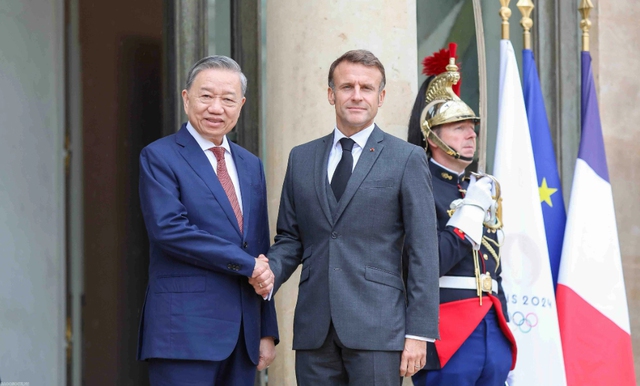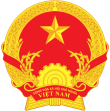Key takeaways from Viet Nam over the past year
VGP – Australian professor Carlyle Thayer has reflected on major developments in Viet Nam since To Lam become General Secretary of the Communist Part of Viet Nam Central Committee in August 2024.

General Secretary To Lam shakes hands with French President Emmanuel Macron in Paris, October 7, 2024. Photo: VNA
On political aspect, General Secretary To Lam initiated the streamlining Viet Nam's political system. This involved reducing a bloated bureaucracy, merging government and administrative units, and disbanding overlapping structures in the Communist Party of Viet Nam, the Government, National Assembly, People's Courts and People's Procuracies, and the Viet Nam Fatherland Front and its affiliated organizations.
The most significant change was to restructure the local administration system from a three-tiered to a two-tiered system by eliminating the district level, merging communes, and reducing the number of provinces from sixty-three to thirty-four, Thayer told VGP via email.
On economic front, Viet Nam's economy rebounded from a relatively slow GDP growth rate of 5.1 per cent in 2023 to 7.1 per cent in 2024. GDP growth rose to 7.5 percent in the first half of 2025 despite the disruptions to global trade caused by President Donald Trump's imposition of across-the-board tariffs.
Viet Nam appeared to have negotiated a favourable "free and fair trade framework agreement" with the US with tariffs set for most goods at 20 per cent and 40 per cent for goods transshipped from a third country.
General Secretary To Lam set a target of 8 per cent GDP growth in 2025 and double digit growth in the following years.
Regarding diplomatic front, Viet Nam scored remarkable success in diplomacy over the past year by raising relations with six countries – France, Malaysia, New Zealand, Indonesia, Singapore and Thailand – to comprehensive strategic partnerships.
Significance of such changes in current global context?
Thayer said Viet Nam's GDP growth rate over the last year made it one of the fastest growing economies in Southeast Asia. Viet Nam's maintenance of macro-economic and political stability have made it an attractive destination for foreign investment. In other words, Viet Nam's exports and a steady flow of foreign investment have been the principal drivers of economic growth.
The Australian professor said Viet Nam's international competitiveness should be enhanced if its restructured political system successfully overcomes the "three bottlenecks" of institutions, infrastructure, human resources and becomes more efficient and productive through digital transformation. He emphasized that this will assist Viet Nam in meeting the goals set by the Thirteenth National Congress in 2021 of "becoming a developing country with a modern industry and high-middle income by 2030 and a developed country with high income by 2045."
Viet Nam's economic success will enhance its ability to retain its independence and strategic autonomy, Thayer noted.
Role of comprehensive strategic partnership/strategic partnership with major powers
Thayer said Viet Nam's network of strategic and comprehensive strategic partnerships with major powers is a key component of To Lam's "four pillars" to support Viet Nam's rise in the new era as his third pillar is Resolution No. 59-NQ/TW On International Integration in the New Situation (January 2025).
The other three pillars have a domestic focus: Resolution No. 57-NQ/TW On Science, Technology, Innovation and National Digital Transformation (December 2024), Resolution No. 66-NQ/TW On Law-Making and Enforcement (April 2025), and Resolution No. 68-NQ/TW On Private Sector Economic Development (May 2025).
Viet Nam currently has a network of thirty-five comprehensive, strategic and comprehensive strategic partnerships that reflect its high standing in the international community.
The country has thirteen comprehensive strategic partnerships including four of the five permanent members of the UN Security Council – China, France, Russia and the United States. The others are India, South Korea, Japan, Australia, Malaysia, New Zealand, Indonesia, Singapore, and Thailand.
Viet Nam's network of strategic and comprehensive strategic partnerships are valuable to Viet Nam for two major reasons. First, they provide a conduit for political influence through the exchange of high-level delegations. Second, this network of strategic and comprehensive strategic partnerships serves to build interdependence across the spectrum of bilateral relations promoting cooperation in diplomacy, economy, energy, science and technology, innovation, education, human resource training, sports, tourism and people-to-people exchanges./.
